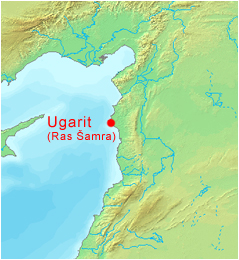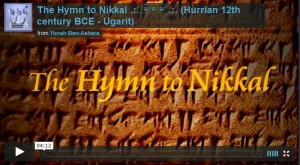The Hymn to Nikkal
The Hurrian Hymn to Nikkal from 12th century BCE Ugarit in Syria is currently the oldest piece of annotated music known to history being well over 3,200 years old. It dates from between 1400 and 1200 BCE and was discovered in the libraries of the city of Ugarit, today called Ras Shamra.
 Although it was written in Ugaritic cuneiform it is actually in Hurrian rather than a West Semitic dialect such as Akkadian, Canaanite, Amorite, Aramaic, or proto-Hebrew. This is a hymn to the Great Goddess Nikkal (Nikkalu in Ugaritic) composed by a sacred scribe by the name of Hammurapi.
Although it was written in Ugaritic cuneiform it is actually in Hurrian rather than a West Semitic dialect such as Akkadian, Canaanite, Amorite, Aramaic, or proto-Hebrew. This is a hymn to the Great Goddess Nikkal (Nikkalu in Ugaritic) composed by a sacred scribe by the name of Hammurapi.
In addition to the words of the prayer there are also instructions for the tuning of the kinnor (lyre) and these have been the focus of several studies by palaeo-musicologists.
The ‘Hurrian Moonrise’ has become a famous prayer song since its discovery in the early 1950s. The archaeologists were excavating the Royal Palace at Ugarit and found the the complete song is one of about 36 such hymns in cuneiform writing, found on fragments of clay tablets. The French archaeologist Emmanuel Laroche published the first accounts in 1955 and 1968. For a more on the Hurrian songs visit the Wikipedia page. To learn more about the Great Goddess Nikkal then please visit the Wikipedia page.
One version of the hymn which was recorded by Tiger Shade studios in the UK is based on the work of Professor Anne Kilmer and Professor Theo Krispijn. The musical arrangement is by Declann Flynn (Al-pha-X) and the beautiful voice is courtesy of Ali Eve Cudby (click on image below to the right).
There is also some information about the work of Professor Anne Kilmer on the Bella Roma music site.
For further details about this recording please visit the Tiger Shade page. Here you can listen to the Hymn Of Ugarit in three versions:
There are several other recordings of the Hymn to Nikkal by

